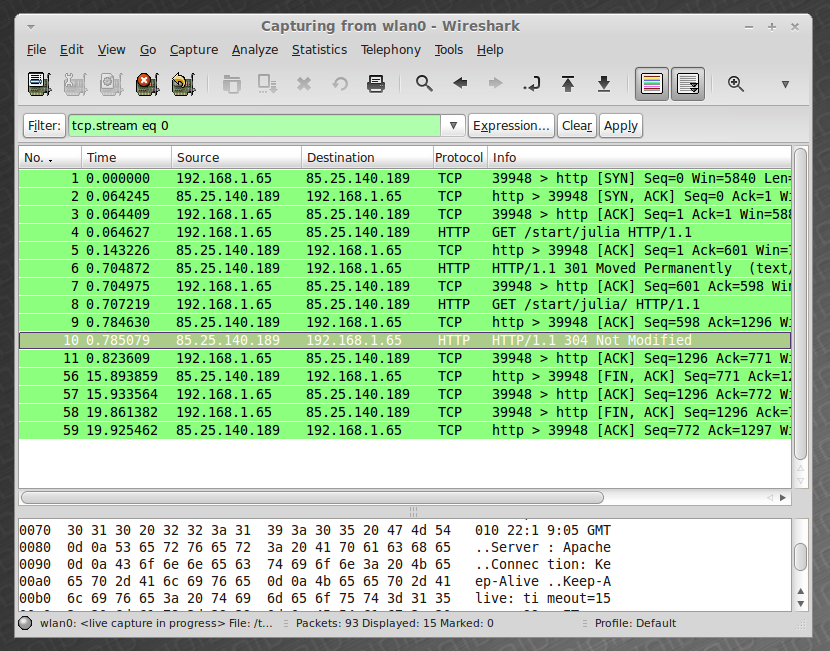
Support for other platforms (macOS, Android, iOS, BSD, and Windows) is provided by a cross-platform wireguard-go implementation.

As of January 2020, it has been accepted for Linux v5.6. Donenfeld (zx2c4) in 2015 as a Linux kernel module. WireGuard was initially started by Jason A. Topic / Item Count Average Min Val Max Val Rate (ms) Percent Burst Rate Burst Start User $ tshark -q -i any -Y http -z http,tree = It will use the pcap library to capture traffic from the first available network interface and displays a summary line on the standard output for each received packet. Without any options set, TShark will work much like tcpdump. TShark's native capture file format is pcapng format, which is also the format used by Wireshark and various other tools. It lets you capture packet data from a live network, or read packets from a previously saved capture file, either printing a decoded form of those packets to the standard output or writing the packets to a file.

Additionally, to view only incoming traffic, replace ip.addr with ip.src to view only outgoing traffic, replace ip.addr with ip.dst. To see all incoming and outgoing traffic for a specific address, enter ip.addr = w.x.y.z in the filter box, replacing w.x.y.z with the relevant IP address. The fields in the template correspond to each filed in the actual flows, but the names may be slightly different.ġ - IN_BYTES in the template is the same as Octets in the flow.Ĥ - PROTOCOL in the template is the same as Protocol in the flows.ħ - L4_SRC_PORT in the template is the same as SrcPort in the flows.Ĩ - IPV4_SRC_ADDR in the template is the same as SrcAddr in the flows.ġ0 - INPUT_SNMP in the templates is the same as InputInt in the flows and will have the raw ifindex of the IN interface.ġ1 - L4_DST_PORT in the templates is the same as DstPort in the flows.ġ2 - IPV4_DST_ADDR in the templates is the same as DstAddr in the flows.ġ4 - OUTPUT_SNMP in the templates is the same as OutputIn in the flows and will have the raw ifindex of the OUT interface.Enabling Network Name Resolution will increase the captured traffic due to additional DNS requests.
Wireshark linux logs how to#
To view the actual values for these fields being sent, clear the cflow.template_id filter and click on any other data gram.Įxpand where it says "Cisco NetFlow/IPFIX" and expand one of the Flowsets until you can see a list of the fields and values like below, make note that the "FlowSet Id: (Data)" value matches the template ID, like in this case it is 256, to ensure you are looking at the correct flow:įor steps on how to do this on Windows see the link below: )" You can see a list of the fields being sent and match them up with the required fields from above.ġ2. If you expand the section below which says "Template (ID =. Here you can check to see if the required NetFlow fields are being sent in the template. To find the data gram that has the Netflow template you can enter " cflow.template_id" in the Filter field and it will filter down to only data grams that contain a Netflow Template. If this is the case, you will need to get a longer pcap in order to capture the template.ġ1. On its website, Wireshark describes its rich feature set as including the following: Deep inspection of hundreds of protocols, with more being added all the time. If there is No Template Found, you will not be able to see the flows below this and you will see a message stating "No Template Found". Verify that there is a template and the flows have been decode, by expanding where you see a line like "Cisco Netflow/IPFIX" and see if you can see Flows listed below this. Note if this is SFLOW data, decode as SFLOW instead of CFLOW.ġ0. Click the + sign and change the drop down menu to "Destination (->9995)" and select "CFLOW" on the right and click OK. Move the file via WinScpt or Filezilla over to a Windows computer which has Wireshark installed and open the file.ĩ. Allow the pcap to run for at least 5 minutes, to cancel it enter "ctrl c".ħ. To filter to a specific router IP address you can use a command like below and specify the IP address of the router in the host filter: Tshark -f"port 9995" -i ens33 -F pcap -w /tmp/netflow.pcapĥ. To run a capture for all Netflow traffic coming into the harvester run the command below, using the name of your NIC in the -i flag.

Find the name of the NIC that Netflow data is being sent to by running "ifconfig" like below is ens33, this name will be used in the tshark -i switch in the examples below:Ĥ.
Wireshark linux logs install#
Install wireshark by running the command below and follow the prompts(requires access to the internet or local yum repository):ģ.

Log into a putty session on the RedHat Harvester as root or sudo su.Ģ.


 0 kommentar(er)
0 kommentar(er)
